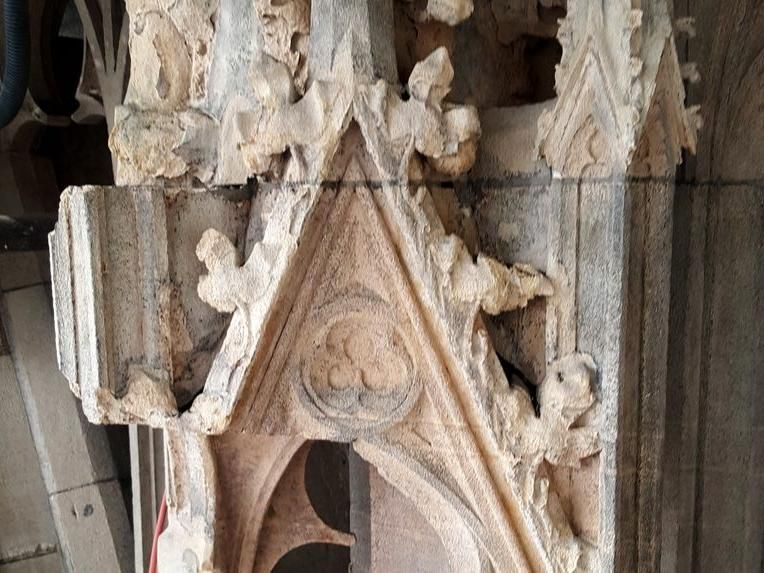Nanoparticles save historic buildings
Research team investigates nano-crystals for more strength of sandstone at DESY
Many historic buildings were built of sandstone, such as Vienna's St. Stephen's Cathedral. Sandstone is easy to work, but does not withstand weathering well. It consists of sand grains that are relatively weakly bonded to each other, so over the years parts of the stone keep crumbling away, often requiring costly restorations.

Clearly visible weathering on St. Stephen's Cathedral in Vienna.
Archiv der Dombauhütte St. Stephan
However, it is possible to increase the resistance of the rock by treating it with special nanoparticles of silicate. The method is already being used, but exactly what happens and which nanoparticles are best suited for this purpose has been unclear until now. A research team from the Vienna University of Technology (TU) and the University of Oslo has now been able to clarify exactly how this artificial hardening process takes place by means of elaborate experiments at DESY's X-ray light source PETRA III and microscopic examinations in Vienna, thereby determining which nanoparticles are best suited for this purpose. The results have been published in the journal Langmuir.
"You use a suspension, i.e. a liquid, in which the nanoparticles initially float around freely," explains research leader Markus Valtiner of TU Wien. "When this suspension gets into the rock, then the aqueous part evaporates, the nanoparticles form stable bridges between the sand grains and give the rock additional stability."
This method is already used in restoration technology, but until now it was not known exactly what physical processes take place. When the water evaporates, a very special kind of crystallization occurs: normally, a crystal is a regular arrangement of individual atoms. However, not only atoms, but also entire nanoparticles can arrange themselves in a regular structure - this is then referred to as a "colloidal crystal".
The silicate nanoparticles come together to form such colloidal crystals as they dry in the rock, thereby jointly creating new bonds between the individual sand grains. This increases the strength of the sandstone. To observe this crystallization process in detail, the TU Vienna research team used the brilliant X-rays from PETRA III, which they used to analyze crystallization during the drying process at the P21.2 measuring station.
"This was very important to understand exactly what the strength of the bonds formed depends on," says lead author Joanna Dziadkowiec of the University of Oslo and TU Wien. "We used nanoparticles of different sizes and concentrations and studied the crystallization process with X-ray analyses." This showed that the size of the particles is crucial for optimal strength.
To this end, the TU Vienna also measured the adhesive force created by the colloidal crystals. For this purpose, a proprietary interference microscope was used, which specializes in measuring tiny forces between two surfaces. "We were able to show: The smaller the nanoparticles, the more they strengthen the cohesion between the sand grains," says Joanna Dziadkowiec. "If you use smaller particles, more binding sites are created in the colloidal crystal between two sand grains, and the number of particles involved thus increases the force with which they hold the sand grains together."
How many particles are present in the emulsion is also important. "Depending on the particle concentration, the crystallization process proceeds slightly differently, and this has an influence on how the colloidal crystals form in detail," says Markus Valtiner. The new findings will now be used to make restoration work more durable and more targeted.
Note: This article has been translated using a computer system without human intervention. LUMITOS offers these automatic translations to present a wider range of current news. Since this article has been translated with automatic translation, it is possible that it contains errors in vocabulary, syntax or grammar. The original article in German can be found here.

































































